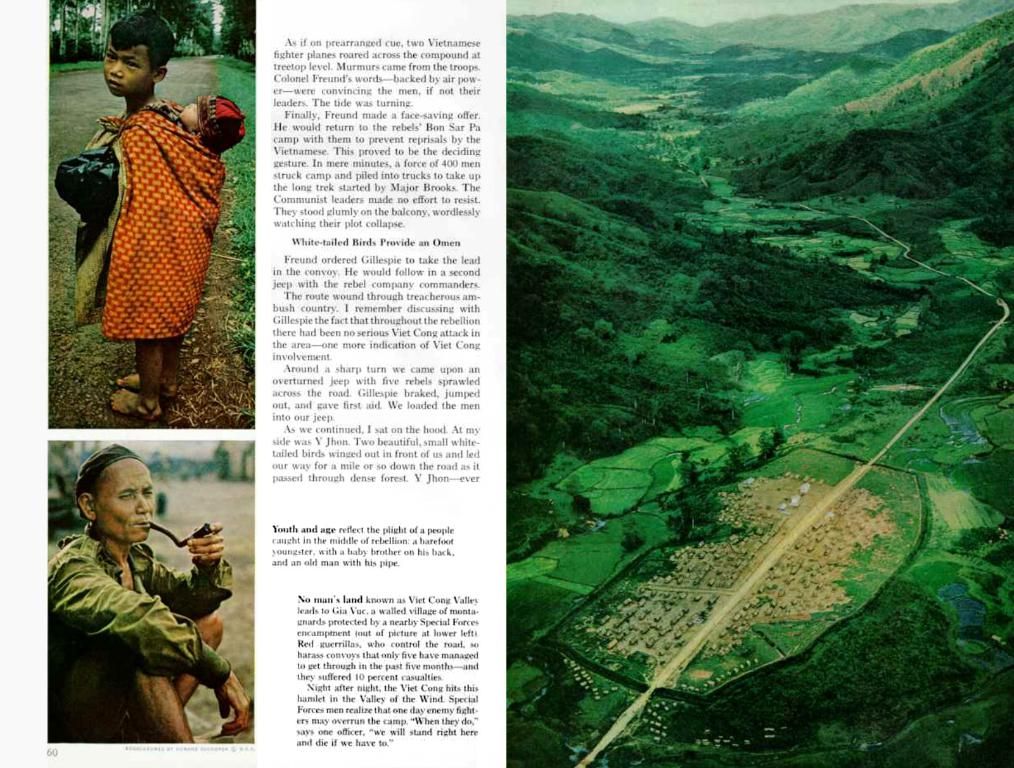Unraveling the Magnificent Khmer Architectural Masterpiece - Angkor Wat
Dive into an odyssey through time and terrain as we unravel the enigma of Angkor Wat! Hidden deep within Cambodia's verdant jungle, this architectural phenom baffles and bewitches all who behold it. This aren't just stones drenched in history; they echo the brilliance and boldness of a bygone civilization.
A Timeless Testament to Tenacity
Whispered into being in the 12th century by the unyielding King Suryavarman II, Angkor Wat was initially a temple honoring the Hindu god Vishnu. Its shift from the historical state religion, Buddhism, marked not only a spiritual change but a turning point in Khmer architecture.
Blending cosmic symbolism with symmetry, Angkor Wat mirrors Mount Meru, the godly home in Hindu folklore. The temple's five towers, rising majestically from the Earth, symbolize Meru's peaks, while the encircling moat and fortifications signify the terrain and the ocean surrounding the divine mountain [1][2]. The unusual westward orientation of the temple sparks intrigue among historians, hinting at interpretations ranging from the symbolism of the sun's setting and death [3].
An Architectural Advance, Ahead of Its Time
Stepping foot inside Angkor Wat is akin to plunging into a three-dimensional blueprint of celestial wisdom. The temple's design, based on concentric, ascending rectangular enclosures, represents the universe in architectural form. This ingenious layout transcends aesthetics; it encapsulates the Hindu concept of the universe in both form and function [1][4].
The bas-reliefs that grace the temple walls are a feat of storytelling. They narrate scenes from Hindu epics like the Ramayana and Mahabharata and offer candid glimpses of the everyday life under the Khmer Empire [5]. These carvings serve as more than mere artistic expressions; they are historical testimonials, forever etched upon the stones.
A Mosaic of Faiths
The transformation of Angkor Wat into a Buddhist temple in the 14th or 15th century is evident in the additions and modifications made to the complex [2]. This blending of Hindu and Buddhist elements is exclusive to Angkor Wat, reflecting the religious tolerance and cultural syncretism of the Khmer civilization [5]. The temple emerged as a canvas on which succeeding generations left their mark, resulting in a multi-layer tapestry of faith and craftsmanship.
The Veil of Time and Nature
Oblivion consumed the splendor of Angkor Wat for centuries, enshrouding it beneath the dense foliage of the jungle. It wasn't until the 19th century that French explorers stumbled upon this marvel, paving the way for the rest of the world to marvel at the grandeur of Khmer architecture [6]. Since then, extensive restoration efforts have been made to protect this priceless piece of history for future explorers.
A Beacon of National Pride
Today, Angkor Wat stands as a symbol of Cambodia's own identity. So revered is it that its image graces the country's flag, a rare honor bestowed upon a historical monument. Angkor Wat about much more than a tourist destination; it's a pilgrimage site for the Cambodian people. It's a stirring reminder of their rich history and an emblem of the resilience and enduring spirit of the Khmer civilization [7].
Modern Challenges
Like many world heritage sites, Angkor Wat grapples with contemporary issues. The growing ranks of tourists put enormous pressure on the fragile structures. Preservation efforts must grapple with the delicate balance between accommodating visitors and protecting the site's sanctity. Furthermore, environmental threats, such as climate change and urbanization, continue to jeopardize the temple's stability [8]. Innovative solutions and international cooperation are requisite to ensure Angkor Wat's longevity and legacy.
Barefooted Giants
Visiting Angkor Wat is a humbling experience. As you traverse its labyrinthine corridors, ascend steep steps, and gaze upon the intricate carvings, it's impossible not to feel the presence of the ancients. Each stone seems to carry a story, whispering secrets vividly etched upon their surfaces [1]. A visit during sunrise speaks to the essence of Angkor Wat's magic; the first rays of sunlight painting the sky in hues of orange and purple, illuminating the silhouette of the temple in an ethereal symphony of light [9].
Angkor Wat transcends the boundaries of a mere tourist attraction; it's a keystone connecting the past and present, heaven and earth, man and the divine. Its stones carry stories of faith, power, and artistic genius; they form a cherished relic of humanity's collective history. Inascertain the legacy of the Khmer civilization, we must work to conserve Angkor Wat, ensuring that its reverberating tale continues to resonate through the ages.
Feel the weight of history beneath your feet as you explore this architectural triumph, a testament to the ingenuity of the ancients. In the footprints of giants, we walk, listening to the whispers of ages past.
The Artistic Grandeur of Angkor Wat
Delve deeper into Angkor Wat, and you cannot help but be awe-struck by the artistic mastery on display throughout the complex. Over 2,000 images of celestial dancers known as Apsaras gaze from the walls, each exquisitely carved with intricate details, showcasing the pinnacle of Khmer artistry [3][10]. The ethereal figures are more than mere decorative adornment; they represent celestial beauty and spiritual purity [11].
The temple's architecture harnesses an ingenious use of light and shadow. The strategic positioning of Galleries and courtyards creates an interplay of light that changes with the time of day, enhancing the spiritual ambiance of the temple [3]. This mastery of illumination underscores the advanced understanding of the Khmer architects.
The Engineer's Triumph
The construction of Angkor Wat was a staggering feat of engineering. The transportation of sandstone blocks, weighing up to 1.5 tons, from a quarry over 50 kilometers away, was a mammoth logistical undertaking. Estimates suggest that around 5 to 10 million sandstone blocks were used in the construction of the temple [10]. Furthermore, the aqua engineering feats involved in building the temple's extensive moat and water management system were well ahead of their time [2]. These systemic adaptations evince the Khmer Empire's sophistication in environmental management and urban design.
The Spiritual Heart of Angkor Wat
Angkor Wat is more than a historical landmark; it is an abode of spiritual reflection. Despite the passage of centuries and the shift from Hinduism to Buddhism, the temple remains a sacred space of worship. The interweaving of Hindu and Buddhist elements in the temple's architecture and art reflects a deep-rooted spiritual pluralism and respect for diverse religious traditions [12]. For many visitors, a trip to Angkor Wat is a spiritual sojourn. The tranquil environment, the grandeur of the architecture, and the sacred art create a space for introspection and contemplation.
Angkor Wat in Popular Culture
Angkor Wat has captivated the imagination of people worldwide, finding its way into films, literature, and art. Often, it symbolizes the exotic and the mystical. This representation in popular culture has played a crucial role in shaping global perceptions of Cambodia and its heritage, generating interest and tourist traffic. However, it also raises questions about cultural representation and the impact of tourism on the preservation of heritage sites. Balancing the benefits of global exposure with the need for respectful and sustainable tourism practices remains a challenge that confronts Angkor Wat.
Enriching the Future
As we look ahead, the preservation and management of Angkor Wat remain crucial. Efforts by the Cambodian government, UNESCO, and various international organizations are underway to ensure that this world heritage site endures for future generations. These initiatives include sustainable tourism practices, restoration works, and research endeavors to better understand and conserve the site [13][14].
The future of Angkor Wat extends beyond safeguarding stones and carvings; it involves maintaining a living connection with our past. Angkor Wat, a timeless testament to human tenacity and ingenuity, continues to inspire and teach us invaluable lessons about the depths of human potential. For those who venture into its embrace, Angkor Wat remains a glimpse into the tapestry of our collective past and a beacon of hope for our future.
Conclusion
Pathfinders to Angkor Wat embark on a journey through time and spirit, exploring the architectural marvels and spiritual significance of this enduring landmark. In hallowed halls etched with tales of faith, power, and artistic brilliance, we witness firsthand the resilience of a civilization that dared to dream, create, and endure. As we stand shoulder to shoulder with the ancients, we carry the torch of history, ensuring their legacy continues to burn brightly for untold generations.
[1] https://www.cambodia-tourismboard.org/angkor-wat.html[2] https://whc.unesco.org/en/list/153/[3] https://en.wikipedia.org/wiki/Angkor_Wat[4] http://www.angkorwattemple.org/history/architecture.php[5] https://www.britannica.com/topic/Angkor-Wat[6] https://en.wikipedia.org/wiki/Discovery_of_Angkor_Wat[7] https://www.cambodiadaily.com/archives/history/angkor-wat-on-the-national-flag-73130/[8] https://www.nationalgeographic.org/travel/destination/cambodia-angkor-wat-your-guide/[9] https://www.lonelyplanet.com/cambodia/angkor/angkor-wat/cambodia-angkor-wat-at-sunrise[10] https://www.ancient-origins.net/archaeology-news-001915/angkor-wat-one-largest-single-religious-monuments-ever-constructed.html[11] https://www.ancient-origins.net/archaeology-news-002314/apasara-angkor-wat-and-story-kama-ancient-hindu-gods.html[12] https://www.britannica.com/topic/Angkor-Wat/Religious-significance[13] https://whc.unesco.org/en/activities/1586/[14] https://www.cnn.com/travel/article/angkor-wat-restoration/index.html
- Lifestyle and home-and-garden enthusiasts might find inspiration in the architectural marvels of Angkor Wat, applying its delicate use of light and shadow in their own living spaces to create an ambiance of spiritual grace and cultural magnificence.
- As cultural heritage sites like Angkor Wat continue to face contemporary challenges such as mass tourism and environmental threats, effective collaboration between governments, international organizations, and the private sector is essential to preserve these priceless relics and ensure they remain a source of inspiration and education for future generations.
- Pluralism is evident in Angkor Wat's fusion of Hindu and Buddhist elements, showcasing the religious tolerance and cultural syncretism prevalent in the Khmer civilization, inviting travelers to appreciate this rich tapestry of beliefs as they traverse through its sacred halls.




